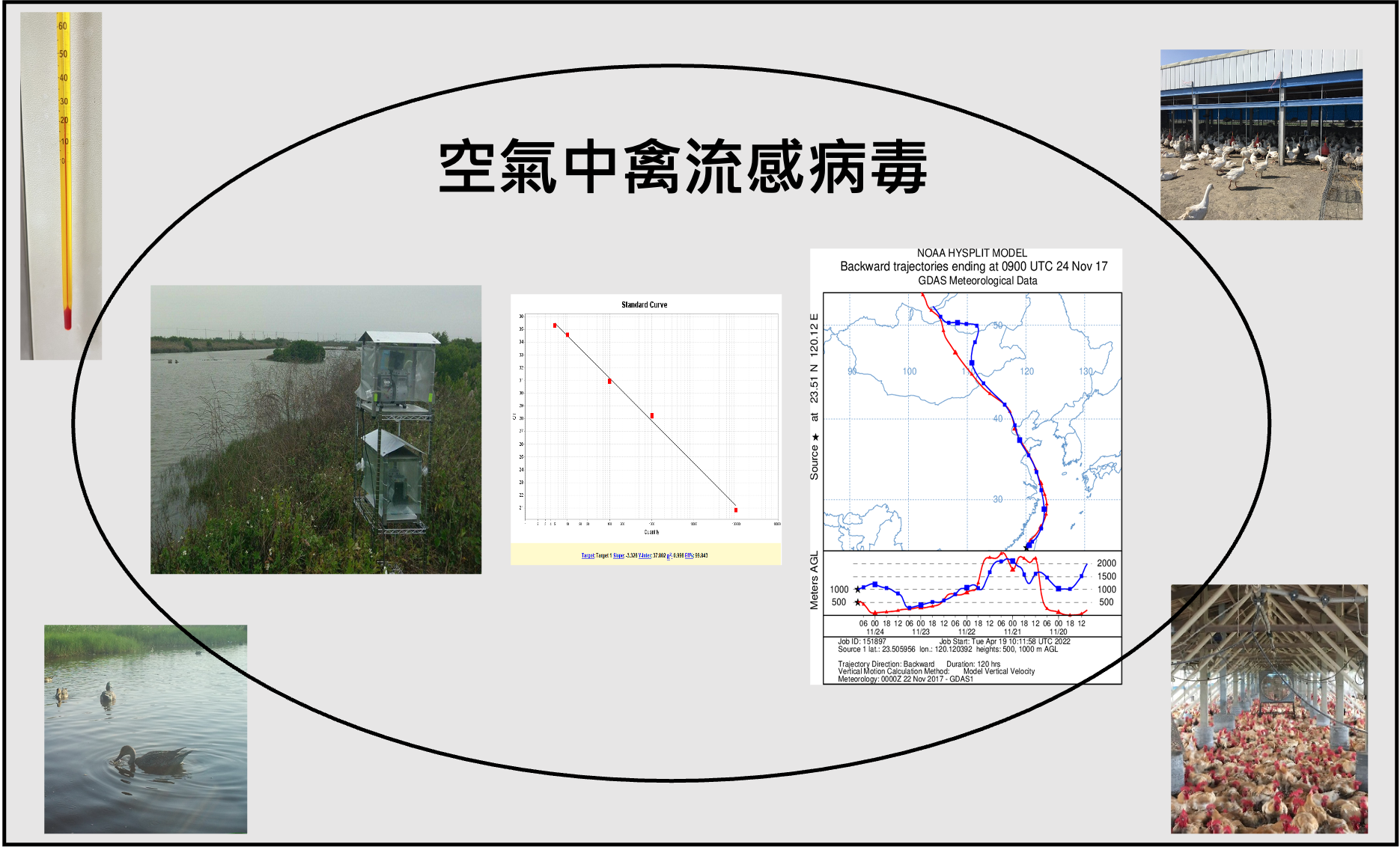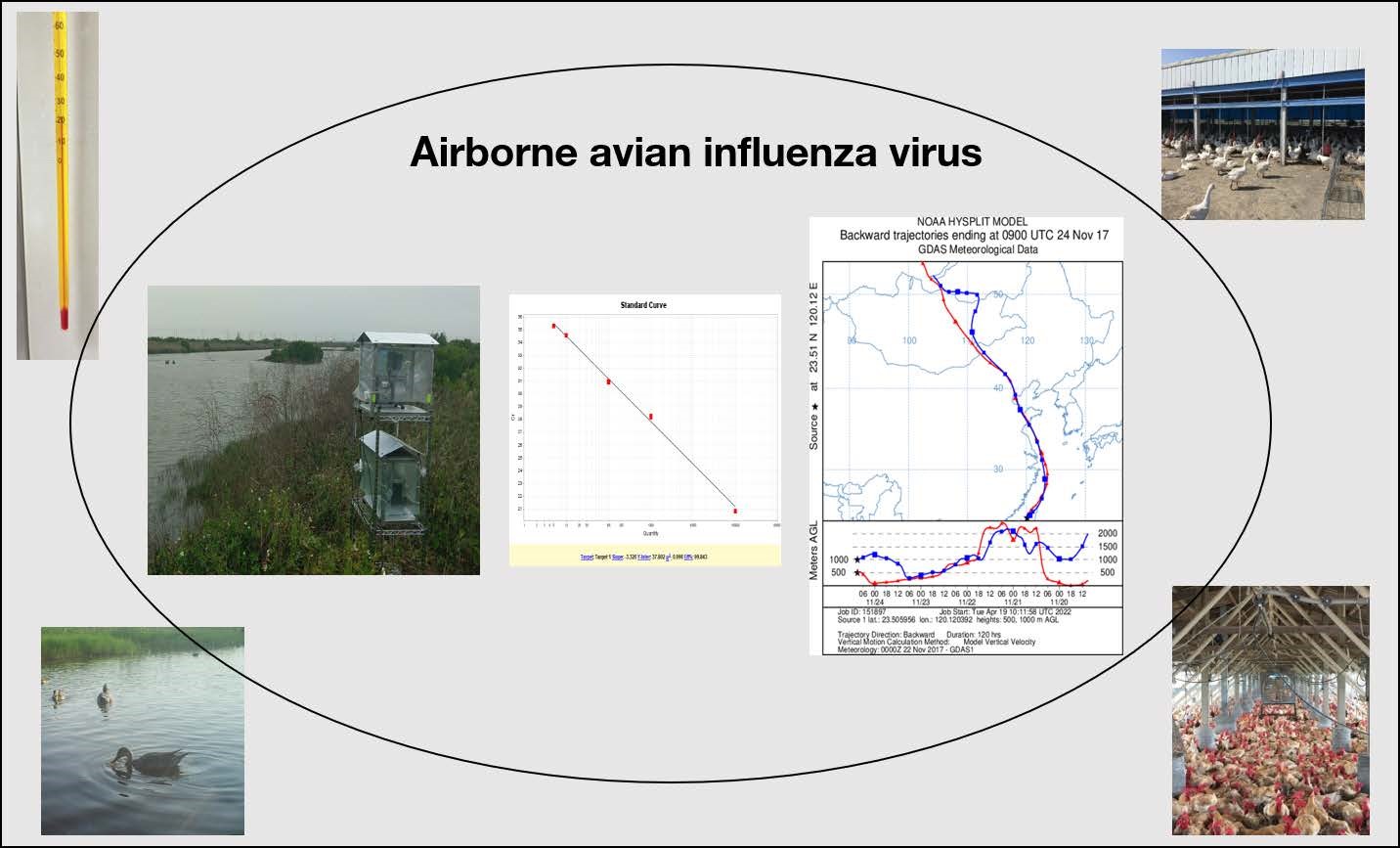候鳥棲息地空氣中禽流感病毒與影響因子
候鳥棲息地空氣中禽流感病毒與影響因子
禽流感病毒爆發對經濟、公共衛生影響甚鉅,在過去已證實禽流感病毒在禽場及活禽市場中可透過空氣進行傳播,此外,候鳥被認為也是傳播禽流感病毒的重要途徑,當候鳥感染H5、H7、H9病毒,在其遷徙的過程中,會導致周圍禽場中的禽隻受到感染,但目前尚未有研究探討空氣中禽流感病毒在候鳥棲息地的濃度,以及影響因子,例如:空氣污染物、氣象因子、及鳥種等。本研究成功的使用空氣中禽流感病毒的採樣方法在候鳥棲息地進行空氣採樣,並使用定量即時聚合酶鏈反應(quantitative real-time polymerase chain reaction )進行病毒RNA分析,結果顯示,空氣中H7的陽性率(12%)高於H5(8%)和H7(10%),且溫度與空氣中禽流感病毒呈現負相關,當溫度越低,空氣中禽流感病毒濃度也越高。此外,空氣中禽流感病毒也會受到冷氣團及候鳥遷徙時期影響,在研究結果顯示,受到冷氣團來襲,空氣中禽流感病毒亞型H9濃度高於非冷氣團期間,指出空氣中禽流感病毒可能受到長程傳輸影響位於下風處的臺灣;空氣中禽流感病毒亞型H7在候鳥遷徙期間,濃度高於背景期,且本研究發現空氣中禽流感病毒與特定鳥種數量呈現正相關,包含:尖尾鴨、小水鴨、花嘴鴨、琵嘴鴨、赤頸鴨、鳳頭潛鴨、反嘴鷸、黑面琵鷺、鷺鶿等鳥種。因此,本研究認為監測大氣中禽流感病毒,或者在候鳥棲息地監測特定鳥種的數量,並透過溫度、冷氣團及候鳥遷徙等因素,了解禽流感病毒對環境的影響,未來對於政府在防治禽流感病毒爆發等政策制定有很大的幫助。

應用與亮點:
1.首次於候鳥棲息地測空氣中禽流感病毒
2.溫度與空氣禽流感病毒呈現負相關
3.空氣禽流感病毒受到冷氣團及候鳥遷徙影響
4.特定鳥種數量與空氣中禽流感病毒呈現正相關
【研究團隊】
團隊成員:張佳琳、陳紫鈺、林思伶、金傳春、陳貞志、陳培詩
代表單位:精準環境醫學研究中心
研究聯繫Email:pschen@gap.kmu.edu.tw
【論文資訊】
論文出處:Environmental science & technology, 56(22), 15365–15376.
全文下載:https://pubs.acs.org/doi/full/10.1021/acs.est.2c04528
Airborne influenza virus in the winter habitat of migratory birds and influence factors
Airborne influenza virus in the winter habitat of migratory birds and influence factors
The outbreaks of avian influenza virus affect economic and public health worldwide. Previous studies had proved that avian influenza virus could spread through air in poultry farms and live poultry markets. In addition, due to the migration, migratory birds could also transmit avian influenza virus and cause the poultry infected. So far, there is no study investigate airborne influenza virus in winter habitat of migratory birds and the influence factors. We conducted a study to detect airborne influenza virus in winter habitat of migratory birds and used quantitative real-time polymerase chain reaction to analyze viral RNA. In our finding, the positive rate of H7 (12%) was higher than H5 (8%) and H9 (10%). The negative correlation was observed between temperature and avian influenza virus. In addition, cold air masses and bird migration could affect the concentration of airborne influenza virus. Both positive rate and concentration of H7 were higher on days affected by colds air masses than those on days not affected by cold air masses, indicating that airborne influenza virus could affect Taiwan (downwind of Korea) through long-range transportation. In addition, the positive rate and concentration of H7 during the bird migration periods were higher than those during the background periods. We also revealed that the positive correlation between airborne avian influenza virus and the numbers of bird species such as pintails, common teals, Indian spot-billed ducks, northern shovelers, Eurasian wigeons, tufted ducks, pied avocets, black-faced spoonbills, and great cormorants. Therefore, this study provides epidemiology insight into avian influenza virus, realizing airborne avian influenza virus could be affected by temperature, cold air masses, and specific species of birds.

Application and Highlights:
1.The first study to detect airborne avian influenza virus in winter habitats of migratory birds.
2.The negative correlation between airborne influenza virus and temperature.
3.Cold air masses and bird migration affect the airborne H9 and H7.
4.The positive correlation between airborne avian influenza virus and the numbers of specific birds.
Research Team Members: Jia Lin Zhang, Zi-Yu Chen, Si-Ling Lin, Chwan-Chuen King, Chen-Chih Chen, and Pei-Shih Chen
Representative Department: Research Center for Precision Environmental Medicine
Contact Email:
Pei-Shih Chen pschen@gap.kmu.edu.tw
Publication: Environmental science & technology, 56(22), 15365–15376.
Full-Text Article: https://pubs.acs.org/doi/full/10.1021/acs.est.2c04528


